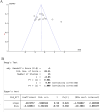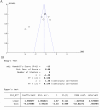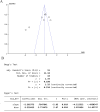Efficacy of acupuncture on lower limb motor dysfunction following stroke: A systematic review and meta-analysis of randomized controlled trials
- PMID: 40333934
- PMCID: PMC12057971
- DOI: 10.1371/journal.pone.0312918
Efficacy of acupuncture on lower limb motor dysfunction following stroke: A systematic review and meta-analysis of randomized controlled trials
Abstract
Background: Acupuncture is widely used for Lower Limb Motor Dysfunction Following Stroke (LLMD) in China, though its effectiveness remains unclear. This meta-analysis aims to evaluate the effectiveness of acupuncture for LLMD.
Methods: We searched eight databases, including PubMed, Embase, Web of Science, Cochrane Library, China National Knowledge Infrastructure, Wanfang, VIP, and CBM, up to December 2023. Randomized controlled trials on acupuncture therapy for LLMD after stroke were included in this study. Outcome measures included motor function, balance function, walking ability, and daily living activities. Two researchers conducted independent literature screening, data extraction, and quality assessment in accordance with Cochrane Collaboration network's standards. Review Manager 5.3 and Stata 17.0 were used in data analysis. Results were presented as mean difference (MD) or standardized mean difference (SMD) with 95% confidence interval (95% CI).
Results: Twelve studies involving 1318 patients, most of which showed low or unclear risk of bias, were included in this review. Meta-analysis results indicate that compared with conventional treatment, acupuncture intervention can improve scores in Fugl-Meyer Assessment for lower scale (SMD = -0.48, 95% CI [-0.92, -0.04], Z = 2.16, P = .03), Berg Balance Scale (SMD = -0.86, 95%CI [-1.65, -0.07], Z = 2.14, P = .03), Functional Ambulation Category scale (SMD = -0.74, 95%CI [-2.33, 0.84], Z = 0.92, P = .36), and Modified Barthel Index Scale (SMD = 0.27, 95%CI [-0.30, 0.84], Z = 0.94, P = .35).
Conclusion: The results of this study suggest that acupuncture combined rehabilitation training may be more effective than conventional rehabilitation alone in improving LLMD, balance function, walking ability, and daily living activities after stroke. Despite limitations due to the low quality of the included studies and methodological constraints, acupuncture combined with rehabilitation training may serve as an effective approach for the treatment of LLMD poststroke.
Copyright: © 2025 Chen et al. This is an open access article distributed under the terms of the Creative Commons Attribution License, which permits unrestricted use, distribution, and reproduction in any medium, provided the original author and source are credited.
Conflict of interest statement
The authors have declared that no competing interests exist.
Figures












Similar articles
-
Acupuncture combined with mirror therapy for post-stroke dyskinesia: A meta-analysis and systematic review.Medicine (Baltimore). 2024 Jun 28;103(26):e38733. doi: 10.1097/MD.0000000000038733. Medicine (Baltimore). 2024. PMID: 38941386 Free PMC article.
-
Effect of theta burst stimulation on lower extremity motor function improvement and balance recovery in patients with stroke: A systematic review and meta-analysis of randomized controlled trials.Medicine (Baltimore). 2024 Nov 1;103(44):e40098. doi: 10.1097/MD.0000000000040098. Medicine (Baltimore). 2024. PMID: 39495989 Free PMC article.
-
Scalp acupuncture for post-stroke spastic hemiparesis: A systematic review and meta-analysis.Medicine (Baltimore). 2024 Mar 1;103(9):e37167. doi: 10.1097/MD.0000000000037167. Medicine (Baltimore). 2024. PMID: 38428878 Free PMC article.
-
Robot-assisted therapy for balance function rehabilitation after stroke: A systematic review and meta-analysis.Int J Nurs Stud. 2019 Jul;95:7-18. doi: 10.1016/j.ijnurstu.2019.03.015. Epub 2019 Mar 28. Int J Nurs Stud. 2019. PMID: 31002951
-
Effect of acupuncture combined with rehabilitation training on sensory impairment of patients with stroke: a network meta-analysis.BMC Complement Med Ther. 2024 Feb 26;24(1):102. doi: 10.1186/s12906-024-04401-9. BMC Complement Med Ther. 2024. PMID: 38409065 Free PMC article.
References
Publication types
MeSH terms
LinkOut - more resources
Full Text Sources
Medical

